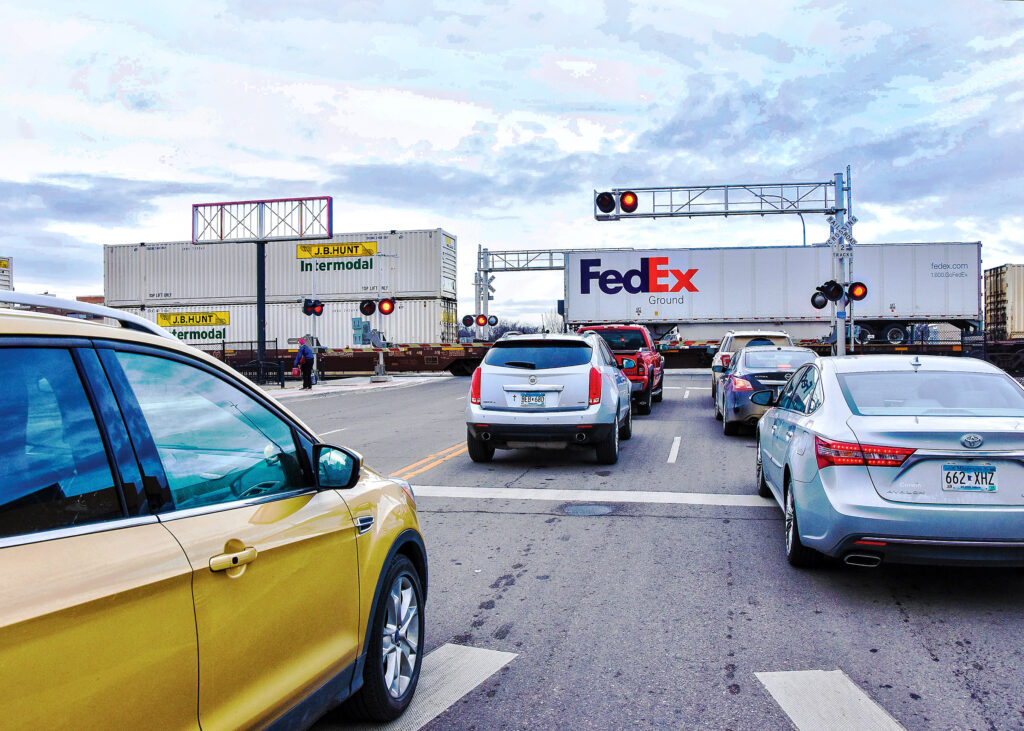
BNSF trains have begun sounding their horns again as they travel through Moorhead as a safety measure for workers constructing the 11th Street underpass. The tooting will take place during working hours — from 6 a.m. through 7 p.m. Monday through Friday. (Photo/Nancy Hanson.)
Nancy Edmonds Hanson
A once-familiar sound that’s been muted for more than 15 years is making a comeback in Moorhead – the ear-splitting toots of locomotives rolling through downtown.
It may be nostalgic, but splitting the quiet-zone silence will spur little nostalgia in days to come. BNSF trains’ horns are being reintroduced for the next three years during the construction season, all in pursuit of a safer work environment for crews constructing the new 11th Street double-dip underpass.
“I haven’t heard the horns yet here in City Hall,” assistant city engineer Tom Trowbridge reports, “but when construction gets within a certain distance of the tracks, they definitely will sound.” Ames Construction will notify the BNSF Railroad of days when its crew will be working close to the tracks. On those days, the railroad’s engineers will be given the go-ahead to loudly warn of their trains’ approach.
The throaty whistles of oncoming trains have been a rarity in Moorhead since 2008, when the two cities established quiet zones on the tracks through their city centers. “It was a quality-of-life thing,” Trowbridge explains. “The noise was considered a significant barrier to redeveloping downtown. If you’re going to hear train horns blowing all night long, living there isn’t very attractive. It’s not helpful for businesses, either.”
But muting the sound of what has grown to 70 trains a day wasn’t as simple as ordering their operators not to toot, back when Moorhead (along with Fargo) began planning for a quiet zone more than 20 years ago. Trowbridge points to a rule still in force today: The crossings must remain at least as safe for cars and pedestrians as they’d be with thundering toots, traditional pairs of crossing arms and flashing lights, following a formula that dictates elaborate safety measures.
That’s necessary, he says, to save impatient travelers on wheels and on foot from their own worst impulses: “When a train is coming, people tend to do a lot of really stupid things.”
Moorhead began laying plans to silence the toots in 2003, the same year Trowbridge joined the city. Groundwork for the sound work was complex and expensive. Quieting the ear-splitting warnings required extensive upgrades to the vehicle and pedestrian crossings.
Fencing was added along both sides of the tracks at intersections and one side along the rest of the line to discourage those on foot from jay-walking across the rails. Three streets that intersected the tracks – Sixth, Ninth and Tenth – were entirely closed, funneling drivers to fewer crossings.
Fourth, Fifth, Eighth, 11th and 14th streets remained open. They were redesigned to strongly discourage drivers from trying to play “beat the oncoming train.” That involved adding two more crossing arms to the pair already on hand, a measure to block them from wheeling around the barriers.
Concrete medians were installed where streets intersect tracks – on both sides of the rails in most cases, or on one side where alley-style business entrances couldn’t be blocked off. They consist of two barriers that force motorists to make 90-degree and then 180-degree turns to reverse course. Like the doubled crossing arms, they are meant to make a calm wait the easier and wiser choice, rather than coming up with an unsafe strategy to outwit the line of boxcars hurtling east or west.
The roar of BNSF’s orange-and-black engines was finally quieted in 2008 after years of work and several million dollars in improvements. “People did, and do, appreciate the quiet,” Trowbridge acknowledges. Under the quiet zone rules, engineers are permitted to sound the horns only when they spot trouble ahead, like a car or truck threading its way around the medians and gates.
But over the next three years, expect to hear much more of that legendary tooting, as trains moving on both sets of tracks sound the alarm from east of 14th Street to the Red River bridges. The good news, he says, is that their loud warnings will only be heard within working hours during the construction season, all during daylight. The bad news: After a reprieve during each of the next two winters, expect the horns to resume when summer comes. The underpass is expected to be complete by the end of 2026.
Engineer Trowbridge offers a final word of advice: “Not only trains, but people need to respect the construction zone. Avoid it as much as you can. It’s all about safety. Give the construction crews plenty of room to do their jobs.”


